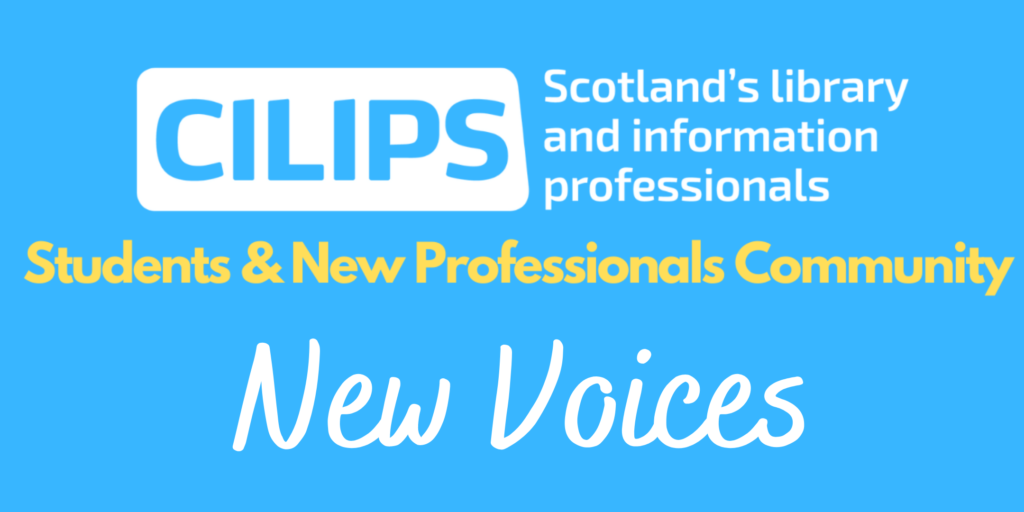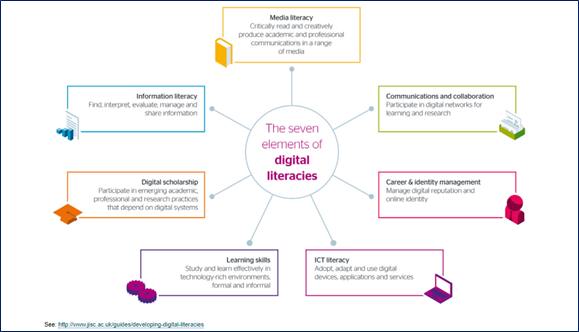New Voices RGU Student Series 2022 – Kirsty Morgan
Category: Blog, New Voices, RGU Student Series 2022
In this 2022 Student Series for the New Voices blog, the CILIPS Students & New Professionals Community will be sharing the views of Robert Gordon University students from the MSc in Information and Library Studies. With special thanks to Dr Konstantina Martzoukou, Teaching Excellence Fellow and MSc Course Leader, for organising these fantastic contributions.
Today, we’re hearing from Kirsty Morgan (@KLMorgan1979), who worked as a theatre and television Stage Manager in London for ten years before moving to the Highlands of Scotland. Kirsty now works with adults with learning difficulties, whilst completing her librarianship training.
Digital Literacy and Generational Differences
‘Age is not a determining factor in students’ digital lives… their familiarity and experience using ICTs is more relevant.’ (Brown and Czerniewicz 2010)
Having spent many frustrating hours teaching my mother how to use a laptop, I find it astonishing that numerous studies have shown that in the context of digital literacy, generational differences do not exist (Kwok-Wing, Lee 2017). There is of course, plenty of evidence of a digital divide, that ‘digital apartheid’ is alive and well, but it is not a division of age. It is a division of the have and have-nots. It is a socio-economic split. A difference of accessibility.
In fact, it has been suggested that the very notion of digital native or digital immigrant (Bayne and Ross 2007) is unhelpful, harmful, and just plain wrong (Brown and Czerniewicz, 2010). Casual use of technology does not equal expertise, and status updates do not a digital literate make.
But what is digital literacy and why is it important?
Jisc suggests that it is not a singular skill, but one made up of seven elements (as above), and that they are ‘essentially a set of academic and professional situated practices’. According to UNESCO, digital literacy is a life skill, as important as reading and writing, and that educators and information professionals need to ‘embed digital literacy in all levels of the educational system’. In their Competencies for Information Professionals of the 21st Century (2003), the Special Libraries Association states that information professionals are ‘essential’ and ‘the life-blood’ of the development of lifelong learning. So clearly the responsibility for the development of digital literacy lies in the hands of the educators and information professionals. But how do they rise to this challenge? What can be done to allow those of differing levels of knowledge to work together in the learning environment across the digital divide?
Perhaps there are three solutions. The immediate course of action is to adapt current methods of teaching across all disciplines, in order to cater for the different kinds of learner (the visual, kinetic, and the aural learner), and to accommodate for all levels of technical knowledge. The use of video lectures, transcripts, activities, one to one sessions, group study, and mobile phone apps is vital to reach every kind of student. Those with less experience of technology should be given extra instruction, and the use of electronic portfolios and mobile phones should be championed. Kaliisa and Picard (2017) found that mobile learning in higher education improved student/teacher collaboration, whilst Thomas, O’Bannon, and Bolton (2013) found that phones were a great leveller amongst students, as their relative low cost allows those from all socio-economic levels to access one.
Educators need to take guidance from UNESCO’s policy brief and make digital literacy part of the curriculum, not a by-product of it. To ensure a ‘cross-national mobility of students in higher education…made possible through blended learning courses’ (UNESCO 2011). Which leads to the second solution, which lies in the hands of the teaching establishments themselves: long-term investment into technology. The establishments must provide the infrastructure, the equipment, and the training that will allow the educators and the information professionals to embrace a new way of teaching, just as the Irish Government did with the IT2000 Plan in 1996 (Makgato 2012, Tedla 2012).
But it appears that the digital divide is not just amongst the students – there are barriers deterring faculty members from adopting digital technology. This may be due to an unwillingness to change, insufficient infrastructure, or lack of confidence (Meyers, Erickson, and Small 2013, Ball and Levy 2009).
So this is our third solution – holistic change. A central, nationally co-ordinated, collaborative approach between student, staff, individual institution, and government, to entrench digital literacy in the curriculum and into teacher training itself (G. Falloon 2020). A bottom-up approach is required, because in achieving digital literacy age is not the determining factor, but familiarity and experience.
Thank you to Kirsty for sharing this thoughtful take on the factors that exacerbate the digital divide and on what steps can be taken at every level of the educational system to help tackle digital inequalities. Stay tuned for more in the 2022 New Voices RGU Student Series coming soon and be sure to check out the rest of CILIPS SNPC’s New Voices blog.
References
BALL, D., and LEVY, Y. (2009). Emerging educational technology: assessing the factors that influence instructors’ acceptance in information systems and other classrooms. J. Inform. Syst. Educ. 19. 431–443.
BAYNE, S. and ROSS, J., 2007, December. The ‘digital native’and ‘digital immigrant’: a dangerous opposition. In Annual Conference of the Society for Research into Higher Education (SRHE). 20.
BROWN, C. and CZERNIEWICZ, L. 2010. Debunking the ‘digital native’: beyond digital apartheid, towards digital democracy. Journal of Computer Assisted Learning. 26 (5): pp. 357-369.
FALLOON, G. 2020. From digital literacy to digital competence: the teacher digital competency (TDC) framework. Education Tech Research Dev 68, pp. 2449–2472.
JISC, 2014. Developing Digital Literacies. [online]. Bristol: Available from: https://www.jisc.ac.uk/full-guide/developing-digital-literacies
(Accessed 28/11/21)
KALIISA, R. and PICARD, M., 2017. A systematic review on mobile learning in higher education: The African perspective. TOJET: The Turkish Online Journal of Educational Technology, 16 (1).
KARPATI, A., 2011. Digital literacy in education. [online]. Moscow: UNESCO Institute for Information Technologies in Education. Available from: https://iite.unesco.org/pics/publications/en/files/3214688.pdf. (Accessed 28/11/21)
KWOK-WING, L., AND SMITH, L. 2017. Socio-demographic factors relating to perception and use of mobile technologies in tertiary teaching: Socio-demographic factors and mobile technologies. British Journal of Educational Technology. 49 (3) pp. 492-504
MAKGATO, M., 2012. Status of teachers’ use of educational technology: a case of some schools in South African semi-urban locations. (online). DOI: 10. 7763/PEDR. 012 47 (23)
MEYERS, E.M., ERICKSON, I. and SMALL, R.V., 2013. Digital literacy and informal learning environments: an introduction. Learning, media and technology, 38 (4), pp.355-367.
SPECIAL LIBRARIES ASSOCIATION, 2003. Competencies for Information Professionals of the 21st Century [online]. Virginia: Available from https://www.sla.org/about-sla/competencies/. (Accessed 28/11/21].
TEDLA, B. A., 2012. Understanding the importance, Impacts and Barriers of ICT on Teaching and Learning in East African Countries. International Journal for e-learning Security (JeLS). 2 (3/4 September/December 2012)
THOMAS, K., and O’BANNON, B. W., and BOLTON, N., 2013. Cell Phones in the Classroom: Teachers’ Perspectives of Inclusion, Benefits, and Barriers. Computers in the Schools, Interdisciplinary Journal of Practice, Theory, and Applied Research. 30 (4), pp. 295-308.

